= Mammillaria zeilmanniana Boed.
Monatsschr. Deutsch. Kakteen-Ges. 3: 227, fig. 1931 as Mamillaria
Accepted Scientific Name: Mammillaria crinita DC.
Mém. Mus. Hist. Nat. 17: 112. 1828

Neomammillaria zeilmanniana (Mammillaria zeilmanniana) Photo by: Valentino Vallicelli
This is a popular species with flowers typically carmine violet to purple-pink in color, seldom white. It is one of the most prolific bloomers among the Mammillarias.
Origin and Habitat: Mammillaria zeilmannianaSN|8915]]SN|8915]], is found at a single location, at San Miguel de Allende in Cañada Virgen, Guanajuato state, central Mexico (extent of occurrence and area of occupancy less than 1 km2).
(Until 1988 Mammillaria zeilmannianaSN|8915]]SN|8915]] had never been found in its natural habitat by anyone else since its original discovery in the late 1920's by Erich Georgi of Saltillo, a collector and exporter of exotic plants. It was then re-discovered after a long search in a canyon complex west of San Miguel de Allende in Mexico thriving in an isolated microenvironment.)
Altitude range: It grows at around 1700-1950 metres above sea level
Habitat: Grows in a very restricted area in a narrow passage with sheer volcanic rock (igneous), large deciduous trees and flowing water offered shade and humidity in an otherwise very dry environment. It roots grow in the thin layer of moss and fern growth that covered the lower, shaded vertical rock that formed the canyon side. It is listed as Critically Endangered because it has a very small population size (less than 250 mature individuals)and an extremely restricted range. The number of mature individuals is declining because of illegal collection. This species is collected by cactus enthusiasts for use as an ornamental. It is cultivated commercially for the international trade.
Synonyms:
See all synonyms of Mammillaria crinita
back
Accepted name in llifle Database:Mammillaria crinita DC.Mém. Mus. Hist. Nat. 17: 112. 1828Synonymy: 50
Accepted name in llifle Database:Mammillaria crinita subs. duwei (Rogoz. & P.J.Braun)[Basionym: Mammillaria duwei Rogoz. & P.J.Braun 1985]Synonymy: 10
Accepted name in llifle Database:Mammillaria crinita subs. leucantha (Boed.) D.R.HuntMammillaria Postscripts 6: 6 (1997)Synonymy: 8
Accepted name in llifle Database:Mammillaria crinita f. nana (Backeb.)[Basionym: Mammillaria nana Backeb. 1966 ]Synonymy: 9
Accepted name in llifle Database:Mammillaria crinita subs. painteri (Rose) U.GuzmánCactaceae Syst. Init. 16: 18 (11 Oct. 2003) Remarks: first published in U.Guzmán et al., Catálogo Cact. Mex.: 120 (May 2003), without basionym referenceSynonymy: 9
back
Common Names include:
ENGLISH: Rose Pincushion Cactus
SPANISH (Español): Biznaguita
Description: Mammillaria zeilmannianaSN|8841]]SN|8915]] (Mammillaria crinita f. zeilmannianaSN|8919]]SN|8919]]) is a popular cactus species with flowers typically carmine violet to purple-pink in color, seldom white. In cultivation it is heavily clustering. (while in its natural environment it is often simple and rarely branching).
Taxonomic notes: Considered a synonym of Mammillaria crinitaSN|8915]]SN|8841]] by Anderson (2001) and the assessors. Accepted as a species by Hunt (1999) and Pilbeam (1999). The claimed distinguishing characters of this taxon, fruit color, appear in other populations of M. crinita while the intensity of the flower color is unique. It appears to be no more than a form albeit a very popular one.
Stems: Glossy green, spherical or oval to short cylindrical, 6-12 cm high, 4.5-8 cm in diameter.
Tubercles: Oval (Tubercle arrangement: 13-21).
Areoles: Woolly when young. The axil is naked.
Radial spines: About 15-18, radiating, finely bristly or hairlike white, pubescent.
Central spines: 4, the upper 3 straight, the lowest hooked, slightly longer than the radials, reddish brown.
Flowers: Up to 2 cm, pale pinkish violet or purple, stigmas yellowish. (The white flowered sport of M. zeilmanniana is produced in cultivation and not known to occur in the wild)
Blooming season: The flowers can come at any time of the year.
Fruits: Whitish green to pale pink.
Seeds: Black.
Subspecies, varieties, forms and cultivars of plants belonging to the Mammillaria crinita complex
 Mammillaria aurihamata Boed.: has golden yellow hooked central spines. Distribution: Mexico, where it occurs in San Luis Potosi, near Real de Catorce.
Mammillaria aurihamata Boed.: has golden yellow hooked central spines. Distribution: Mexico, where it occurs in San Luis Potosi, near Real de Catorce.  Mammillaria brevicrinita Repp.: (Mammillaria crinita) Radial spines 10 - 29, white, finely pubescent, 6 - 9 mm long.
Mammillaria brevicrinita Repp.: (Mammillaria crinita) Radial spines 10 - 29, white, finely pubescent, 6 - 9 mm long.
Central spines: 0 - 7, awl-shaped, yellowish to red to dark brown, 8-16 mm long, one or two hooked.- Mammillaria crinita DC.: This taxon comprises a very variable a complex of forms, variety and species with varible spination. The flowers cream colored to a pink-cream colored. This is one of the most prolific bloomers among the Mammillarias.
 Mammillaria crinita subs. duwei (Rogoz. & P.J.Braun): It is a small cactus with delicate near harmless feathery spines densely wrapped against the body of the cactus. The long central spine is not present on all the clones, they are yellowish, hooked, to 8 mm long, pubescent. The flowers are yellowish/cream to light yellow.
Mammillaria crinita subs. duwei (Rogoz. & P.J.Braun): It is a small cactus with delicate near harmless feathery spines densely wrapped against the body of the cactus. The long central spine is not present on all the clones, they are yellowish, hooked, to 8 mm long, pubescent. The flowers are yellowish/cream to light yellow. Mammillaria crinita subs. duwei f. cristata hort.: crested form completely covered by tight pubescent spines.
Mammillaria crinita subs. duwei f. cristata hort.: crested form completely covered by tight pubescent spines. Mammillaria crinita subs. duwei f. inermis hort.: this is a selected strain with pure feathery radial spines (central spines absent)
Mammillaria crinita subs. duwei f. inermis hort.: this is a selected strain with pure feathery radial spines (central spines absent) Mammillaria crinita subs. duwei f. monstruosa hort.: This is a true oddity and some say that this monster is nothing else than a abnormal root grafted upside down.
Mammillaria crinita subs. duwei f. monstruosa hort.: This is a true oddity and some say that this monster is nothing else than a abnormal root grafted upside down.- Mammillaria crinita f. nana (Backeb.)
- Mammillaria crinita subs. painteri (Rose) U.Guzmán: has red, brown or coffee coloured central spines. With age it may offset from the base to form a small cluster. Distribution: Queretaro and adjacent areas in Hidalgo and Guanajuato.
 Mammillaria crinita subs. painteri f. monstruosa cristata hort.: Crested form. has more bristly spines than the Mammillaria crinita subs. painteri f. monstruosa from which it derives.
Mammillaria crinita subs. painteri f. monstruosa cristata hort.: Crested form. has more bristly spines than the Mammillaria crinita subs. painteri f. monstruosa from which it derives. Mammillaria crinita subs. painteri f. monstruosa hort.: Cultivated mutant characterized by very reduced or absent spines, free branching, and with small pink flowers.
Mammillaria crinita subs. painteri f. monstruosa hort.: Cultivated mutant characterized by very reduced or absent spines, free branching, and with small pink flowers. Mammillaria glochidiata var. xiloensis Repp.: (Mammillaria crinita) Plants irregularly forming tightly packed cluster of egg-shaped balls, up to 5 cm tall with dark yellow fine hooklike spines and pale cream-pink flowers.
Mammillaria glochidiata var. xiloensis Repp.: (Mammillaria crinita) Plants irregularly forming tightly packed cluster of egg-shaped balls, up to 5 cm tall with dark yellow fine hooklike spines and pale cream-pink flowers.- Mammillaria monancistracantha Backeb.: (Mammillaria crinita f. nana)
 Mammillaria scheinvariana R.Ortega V. & Glass: (Mammillaria crinita) Stem covered by numerous hairlike radial spines, giving the plant a shaggy appearance.
Mammillaria scheinvariana R.Ortega V. & Glass: (Mammillaria crinita) Stem covered by numerous hairlike radial spines, giving the plant a shaggy appearance. Mammillaria tezontle W.A.Fitz Maur. & B.Fitz Maur.: has small stems only 1-2 cm in diameter with short, yellow central spination and relatively large flowers. Distribution: North of San Luis Potosi.
Mammillaria tezontle W.A.Fitz Maur. & B.Fitz Maur.: has small stems only 1-2 cm in diameter with short, yellow central spination and relatively large flowers. Distribution: North of San Luis Potosi. Mammillaria trichacantha K.Schum.: (Mammillaria crinita f. nana) It his is a remarkable species on account of its having short hooked brown to yellow/orangish spines that finally turn to gray.
Mammillaria trichacantha K.Schum.: (Mammillaria crinita f. nana) It his is a remarkable species on account of its having short hooked brown to yellow/orangish spines that finally turn to gray.- Mammillaria wildii A.Dietr.: (Mammillaria crinita ssp. wildii) Short brownish to yellow hooked, minutely pubescent central spines and 1 to 15, whitish, smooth, 4 to 5 mm long radials.
 Mammillaria wildii f. cristata hort.: (Mammillaria crinita ssp wildii "cristata") It will form huge crested and free flowering mounds up 40 cm (or more) in diameter.
Mammillaria wildii f. cristata hort.: (Mammillaria crinita ssp wildii "cristata") It will form huge crested and free flowering mounds up 40 cm (or more) in diameter. Mammillaria zeilmanniana Boed.: has flowers typically carmine violet to purple-pink in color, seldom white. Distribution: San Miguel de Allende in Cañada Virgen, Guanajuato.
Mammillaria zeilmanniana Boed.: has flowers typically carmine violet to purple-pink in color, seldom white. Distribution: San Miguel de Allende in Cañada Virgen, Guanajuato. Mammillaria zeilmanniana f. albiflora hort.: is a white flowered sport that was produced in cultivation and not known to occur in the wild.
Mammillaria zeilmanniana f. albiflora hort.: is a white flowered sport that was produced in cultivation and not known to occur in the wild.
Bibliography: Major references and further lectures.
1) Fitz Maurice, B, Fitz Maurice, W.A. & Bárcenas Luna, R. 2013. Mammillaria zeilmanniana. The IUCN Red List of Threatened Species. Version 2014.2. <www.iucnredlist.org>. Downloaded on 02 November 2014.
2) Wikipedia contributors. "Mammillaria zeilmanniana." Wikipedia, The Free Encyclopedia. Wikipedia, The Free Encyclopedia, 23 Sep. 2014. Web. 2 Nov. 2014.
3) Robert T. Craig “The Mammillaria handbook: with descriptions, illustrations, and key to the species of the genus Mammillaria of the Cactaceae” E P Publishing, 1945
4) John Pilbeam “Mammillaria The Cactus File Handbook” Cirio Pub. Services, 01/Dec/1999Edward Anderson “The Cactus family” Timber Press, Incorporated, 2001
5) James Cullen, Sabina G. Knees, H. Suzanne Cubey "The European Garden Flora Flowering Plants: A Manual for the Identification of Plants Cultivated in Europe, Both Out-of-Doors and Under Glass" Cambridge University Press, 11/Aug/2011
6) David R Hunt; Nigel P Taylor; Graham Charles; International Cactaceae Systematics Group. "The New Cactus Lexicon" dh books, 2006
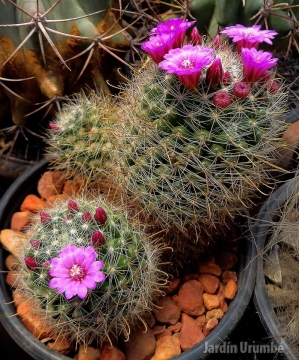 Neomammillaria zeilmanniana (Mammillaria zeilmanniana) Photo by: Alexander Arzberger
Neomammillaria zeilmanniana (Mammillaria zeilmanniana) Photo by: Alexander Arzberger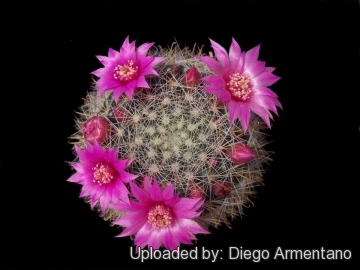 Neomammillaria zeilmanniana (Mammillaria zeilmanniana) Photo by: Diego Armentano
Neomammillaria zeilmanniana (Mammillaria zeilmanniana) Photo by: Diego Armentano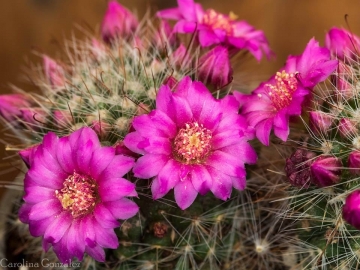 Neomammillaria zeilmanniana (Mammillaria zeilmanniana) Photo by: Carolina González
Neomammillaria zeilmanniana (Mammillaria zeilmanniana) Photo by: Carolina González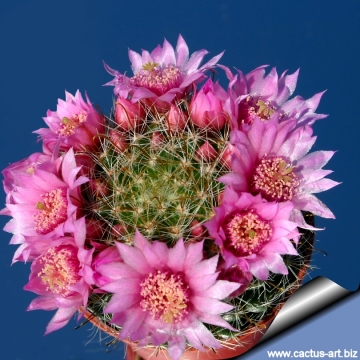 Neomammillaria zeilmanniana (Mammillaria zeilmanniana) Photo by: Cactus Art
Neomammillaria zeilmanniana (Mammillaria zeilmanniana) Photo by: Cactus Art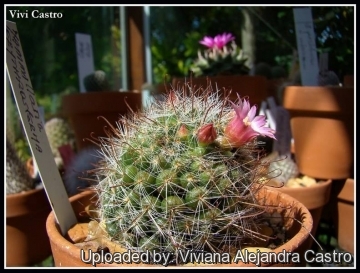 Neomammillaria zeilmanniana (Mammillaria zeilmanniana) Photo by: Viviana Alejandra Castro
Neomammillaria zeilmanniana (Mammillaria zeilmanniana) Photo by: Viviana Alejandra Castro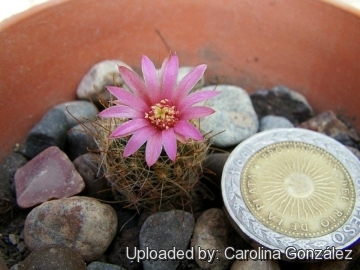 Neomammillaria zeilmanniana (Mammillaria zeilmanniana) Photo by: Carolina González
Neomammillaria zeilmanniana (Mammillaria zeilmanniana) Photo by: Carolina González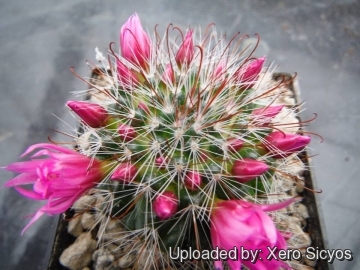 Neomammillaria zeilmanniana (Mammillaria zeilmanniana) Photo by: Xero Sicyos
Neomammillaria zeilmanniana (Mammillaria zeilmanniana) Photo by: Xero Sicyos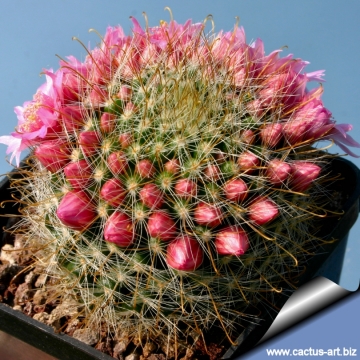 Neomammillaria zeilmanniana (Mammillaria zeilmanniana) Photo by: Cactus Art
Neomammillaria zeilmanniana (Mammillaria zeilmanniana) Photo by: Cactus ArtCultivation and Propagation: Mammillaria zeilmanniana is an easy species in cultivation. Most plants will offset readily, and clumps can be produced in a very few years given the best conditions.
Growth rate: It is a small growing, but easily flowering species.
Soils: It likes very porous standard cactus mix soil.
Repotting: Repotting every 2-3 years. It will need a pot with sufficient depth to allow the tap root. Use pot with good drainage.
Watering: Water regularly in summer, but do not overwater (Rot prone), keep dry in winter. In winter keep the Mammillaria in a very dry place with ample airflow, no humid atmosphere!
Fertilization: During the growing season enrich the soil using a fertilizer rich in potassium and phosphorous, but poor in nitrogen, because this chemical element doesn’t help the development of succulent plants, making them too soft and full of water.
Hardiness: Reputedly sensitive to frost , but less so if kept on the dry side prior to, and during, cold weather (hardy to -5° C for short periods, but some reports give it hardy to -12°C). However some warmth throughout the year will increase the grower's success (minimum 5° to 8°C during rest season).
Exposition: Outside bright sun, filtered sunlight or afternoon shade, inside it needs bright light, and some direct sun. Subject to sunburn if exposed to direct sun for too long. Tends to bronze in strong light, which encourages flowering and heavy wool and spine production.
Uses: It is an excellent plant for container growing. It always looks good and stays small. It look fine in a cold greenhouse and frame.
Pests & diseases: It may be attractive to a variety of insects, but plants in good condition should be nearly pest-free, particularly if they are grown in a mineral potting-mix, with good exposure and ventilation. Nonetheless, there are several pests to watch for:
- Red spiders: they may be effectively rubbed up by misting the vulnerable plants every day
- Mealy bugs: Easily they develop aerial into the new growth among the wool with disfiguring results, but the worst types develop underground on the roots and are invisible except by their effects.
- Sciara Flies: they are one of the major problems for seedlings. It is a good practice to mulch your seedlings with a layer of grit, which will strongly discourage the flies.
- Scales: they are rarely a problem.
It is wise to treat your whole collection with a systemic insecticide twice a year in spring and autumn.
- Rot: it is only a minor problem with mammillaria if the plants are watered and “aired” correctly. If they are not, fungicides won't help all that much.
Propagation: Direct sow after last frost or (rarely) cuttings. Seeds germinate in 7-14 days at 21-27° C in spring, remove the glass cover gradually as the plants develops and keep ventilated, no full sun for young plants! To make a cutting twist off a branch and permit it to dry out a couple of weeks, lay it on the soil and insert the stem end partially into the soil. Try to keep the cutting somewhat upright so that the roots are able to grow downward.
Your Photos
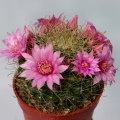
by Valentino Vallicelli
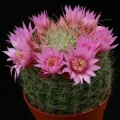
by Valentino Vallicelli
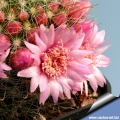
by Cactus Art

by Carolina González

by Cactus Art























